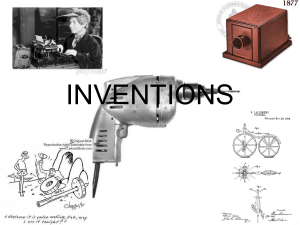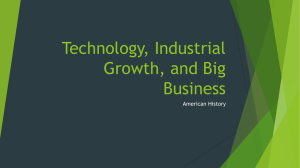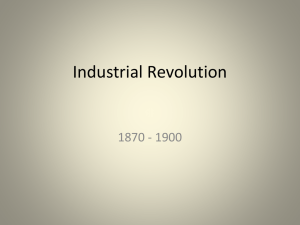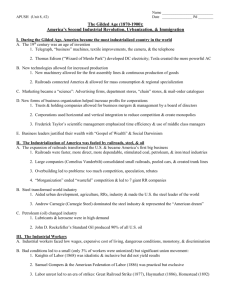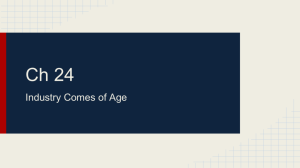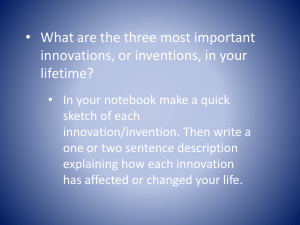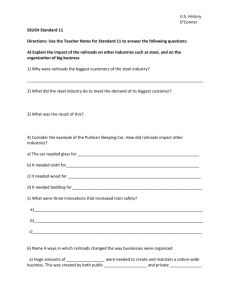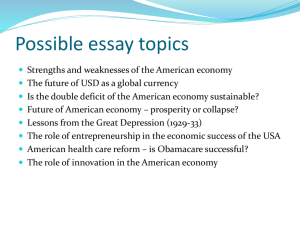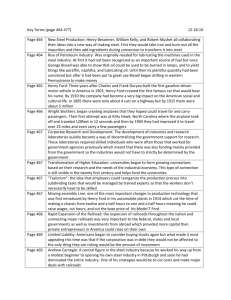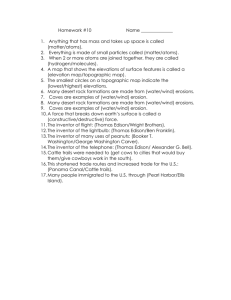File
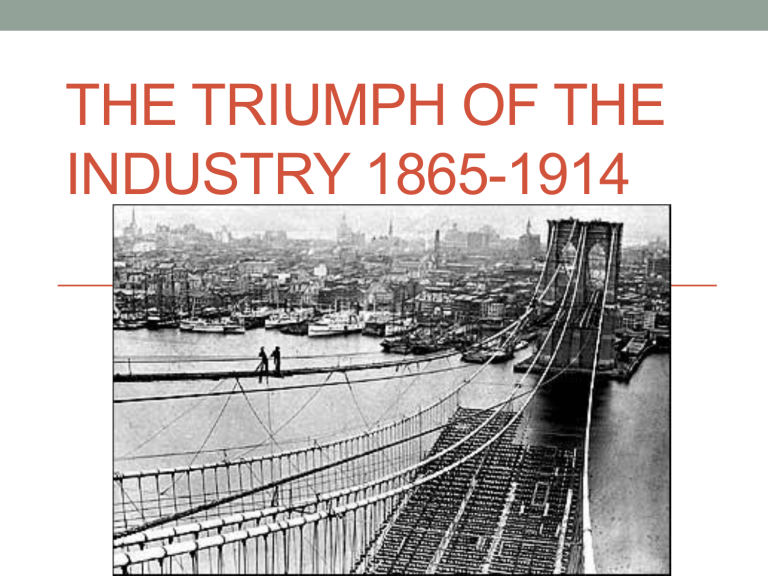
THE TRIUMPH OF THE
INDUSTRY 1865-1914
Section 1: Technology and Industrial
Growth
Terms and People
• Entrepreneur – people who invest money in a product of enterprise in order to make a profit
• Protective Tariff – taxes that would make imported goods cost more than those made locally
• Laissez Faire – allows businesses to operate under minimal government regulation (hands-off)
• Patent – is a grant by the federal government giving an inventor the exclusive right to develop, use, and sell an invention
Terms and People
• Thomas Edison – inventor supported by wealthy industrialists like J.P. Morgan, established a research laboratory at Menlo Park, New Jersey
Terms and People
• Bessemer Process – a process for purifying iron, resulting in strong, but lightweight, steel
Terms and People
• Suspension Bridges – bridges in which the roadway is suspended by steel cables
Terms and People
• Time Zones – one for each hour of the day, adopted by the railroads and still in use today
• Mass Production – a system for turning out larger numbers of products quickly and inexpensively
America’s industrial revolution was known as the “second industrial revolution,” driven by business leaders, creative inventors and scientists
Encouraging Industrial Growth
One spark to this growth was the Civil War o Guns o Ammunition o Medical supplies o Uniforms o Food
Immigration was encouraged to meet demand for labor o Pushed from homelands by political and religious upheaval along with crop failures
Natural resources fueled much of this growth, coal, lumber, rivers, and oil
Government
The government played a key role in the industrial revolution. They gave millions of acres to the railroads, imposed tariffs to encourage “buying American,” and held a laissez-faire attitude toward business dealings.
Innovation Drives the Nation
Patents increased rapidly, and businessmen invested in new innovations, hoping to create new industries and expand old ones.
Inventor Thomas Edison supported by J.P. Morgan gave us light, and central power plants
Steel – skyscrapers, elevators, and bridges
Transportation
• Rail travel made great leaps in the transportation of people and goods. How did railroads contribute to the growth of American cities? (pg. 105)
The impact of Industrialization
• Industrialization allowed the U.S. to dominate world markets. (grain, steel and textiles)
• The U.S. had more miles of rail track then the rest of the world combined
Section 2 The Rise of Big Business
Terms and People
• Corporation – type of group ownership, with shares
• Monopoly – complete control of a product or service
• Cartel – in this arrangement businesses with the same product agree to limit production to increase prices
• John D. Rockefeller – an oil tycoon, made deals with railroads to increase profits
Terms and People
• Horizontal integration – consolidating small companies in the same business to lower costs (read pg. 110)
• Trust – companies assign their stock to a board of trustees
• Andrew Carnegie – business tycoon who along with others consolidated all aspects of production to lower cost of production (read pg. 113)
• Vertical integration – the term used to define the consolidation process (read pg. 111)
Terms and People
• Social Darwinism – term coined by Graham Sumner to describe “wealth or one’s inherent value and those who had it were the most “fit”
• ICC – (Interstate Commerce Commission) first federal body to monitor American business operations
• Sherman Antitrust Act – outlawed any trust that operated
“in restraint of trade or commerce among the several states”
Section 3: The Organized Labor
Movement
Terms and People
• Sweatshops – workers (mainly immigrants) worked 12 hour days, 6 days a week, in small and dirty workhouses
• Company Towns – communities, owned by the business and rented out to employees
Terms and People
• Collective Bargaining – negotiating as a group for higher wages or better working conditions
• Socialism – an economic and political philosophy that favors public, instead of private, control of property and income
• Knights of Labor – labor union and secret society, devoted to broad social reform, such as replacing capitalism with workers’ cooperatives (read Primary Source pg. 117)
Terms and People
• American Federation of Labor (AFL) – founded by Samuel
Gompers, this was a craft union, started with cigar makers’ and later composed of more than 100 other trade unions (Why combine groups?)
• Haymarket Riot – Chicago strikers demonstration that left a legacy of violence when a protester threw a bomb killing policemen
Terms and People
• Eugene V. Debs – the head of the American Railway
Union, he believed that industrial unions allowed groups to exert united pressure on employers, he was eventually imprisioned
• Pullman Strike – escalated, halting both rail and mail traffic, Rail owners cited the Sherman Antitrust Act saying the strike disrupted free trade (read pg. 120)
